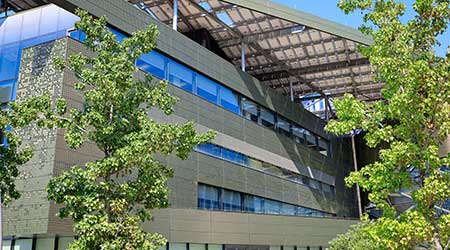How Real-Time Energy Monitoring Saves Energy
OTHER PARTS OF THIS ARTICLEPt. 1: This Page
The San Mateo County Community College District (SMCCCD) is a three-college district located between San Francisco and Silicon Valley serving more than 40,000 students each year and offering the first two years of instruction in a wide variety of transfer programs as well as more than 90 vocational-technical programs. Students can earn either Associate in Arts or Science degrees or receive Certificates of Proficiency in their chosen fields.
Recently, the campuses undertook an energy efficiency project to upgrade the district’s building automation and control systems and install Building Analytic, a Schneider Electric solution that provides continuous real-time analysis of all building systems and converts data into actionable insights to identify energy and cost-saving opportunities.
A highlight of the project, however, will be adding the capability to do real-time energy monitoring. SMCCCD’s energy and sustainability manager Joe Fullerton answered a few questions about the importance of real-time monitoring.
1. What are the main advantages of real-time energy monitoring? How exactly does real-time energy monitoring help save energy? How do FMs/energy managers avoid drowning in data?
Energy monitoring in general is critical. Paraphrasing Peter Drucker: you can’t manage what you don’t measure. Real-time monitoring takes things a step further, allowing facility managers and operators to begin a shift from a long reactive cycle to a much shorter reactive cycle toward being proactive.
Making smart energy decisions based on conditions in the past is difficult and expensive, given that energy has been wasted for the entirety of the reactive period. Real-time monitoring allows facility managers to better manage and analyze the vast amount of data being gathered from their buildings and point out where inefficiencies are occurring – shortening the reactive period significantly and saving significant amounts of energy. Using data available in real time enables facility managers to adjust HVAC, lighting, electrical distribution systems and other systems based on information gleaned from the system. Users can, at a glance, see system level inefficiencies and pivot operations quickly to reduce energy use. Schneider Electric’s energy and systems monitoring software can also be used to compare day-to-day usage to accurately forecast energy consumption. This can help ensure that real time adjustments of the systems are having the desired effect and help further influence behavioral changes over time. The data is presented in a way that’s easy-to-use and digest through interactive graphs, modules and comparisons, helping facility managers avoid data overload.
2. How will the data be used for long-term trending and analysis? How will this information help set energy efficiency strategy?
At San Mateo County Community College we are planning to use the system to conduct monitoring based commissioning (AKA: continuous commissioning) efforts across all three of our campuses. Being able to benchmark building and/or system energy use, make an adjustment and then measure the delta of improvement will enable the District to take advantage of utility incentives, prioritize operational expenses, and develop appropriate capital projects to further our efficiency efforts. By initiating these efforts, and leveraging powerful real-time, trending and analytical functions of the Schneider Electric StruxureWare system, the District will shift from reactive facilities management to proactive facilities management. The new suite of Building Analytics tools in particular, will allow facility mangers to not only pinpoint which systems and equipment have irregularities, but prioritize actions based on energy cost, severity and occupant comfort. Optimizing systems before problems get really bad, rather than responding to alarms after the fact, is the ultimate goal. This forward-looking approach helps building owners and managers more intelligently shape their energy efficiency strategies for the 82 buildings across our three campuses. This new system will help SMCCCD make wiser operational decisions, have a clearer outlook on capitol reinvestment needs and better plan for our critical mission - to support excellence in higher education.
Related Topics:











